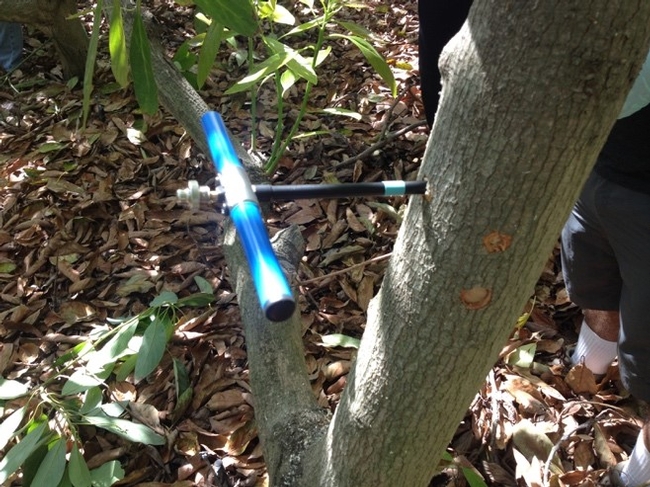Two closely related Ambrosia beetles (Euwallacea sp.) have been identified in commercial avocado groves in California. The polyphagous shot hole borer (PSHB), detected in Los Angeles, Orange counties and recently in Ventura county, and the Kuroshio shot hole borer (KSHB), detected in San Diego and recently in Orange and Santa Barbara counties, are morphologically indistinguishable, but genetically distinct. Already widespread in a variety of reproductive host trees common in the urban landscape (including box elder, willow, several maples, oak and sycamore species), the beetles represent a significant threat to trees in both landscape and agricultural settings. Adult females construct galleries in the xylem system of host trees, where they cultivate symbiotic fungi (Fusarium, Paracremonium and Graphium spp.) as a food source for their developing young. The fungi are taken up by progeny females in specialized organs within their mouthparts, and transported to other sites within the same tree, where new colonies are established, or to newly colonized hosts. The galleries compromise the structural integrity of infested trees, which can represent a serious safety hazard in urban environments, and disrupt the flow of water and essential nutrients within the xylem. In addition to the physical damage, the fungi extract nutrients from the xylem system, further depriving the tree of nutrients essential for healthy growth and fruit production.
An effective biological control agent is not yet available to manage the SHB in California, and so management for now must rely on the use of chemical pesticides. The control of Ambrosia beetles and their associated fungi using
chemical pesticides is complicated because of their location inside the host trees. The application of insecticides to the external surfaces of trees, where the beetles must first alight prior to boring, has the potential to kill beetles by contact activity, and they may also have the potential to control emerging young adults before they can re-infest the trees.
The drawback of surface treatments is that multiple applications are often required because of the relatively short duration of efficacy. In addition, once the beetle burrows inside the tree, surface treatments are become ineffective. One possible solution to this problem may be the use of systemic pesticides, and scientists at UC Riverside are evaluating the use of both systemic insecticides and fungicides in a 2-pronged attack against the symbiotic system.
Systemic pesticides are mobile within the xylem system of plants, and the fungicides could potentially target the fungi growing in the xylem and deprive the beetle larvae of a food source. The insecticides would prevent the beetle from establishing galleries within susceptible tree hosts, and prevent the survival of beetles and their offspring already present within trees. The big problem with systemic pesticides is getting sufficient concentrations of chemicals to the areas within the trees where the beetle and fungus occur. Although there are exceptions, most systemic treatments are administered to the soil for uptake through the roots. However, in mature avocado groves, the high organic matter content of the soil can prevent effective absorption by roots because the pesticide becomes bound to organic components within the soil. Trunk injection of pesticides directly into the vascular system of trees eliminates the potential for binding of pesticides within the soil, and increases the amount of active ingredient inside the tree available to impact the beetle/fungal system. Systemic pesticides must be formulated for trunk injection and so careful evaluation is needed to ensure optimal efficacy. Trials are being conducted with the assistance of avocado industry and grower collaborators in areas where the SHB has been recorded. The chemicals are injected into the trees using commercially available equipment, and the movement of the active ingredients is then monitored over time in wood core samples taken at different heights of the trees. Two methods are being used to confirm the presence of the chemicals. Insecticides are being quantified using ELISAs that are specific for the active ingredients under investigation. Wood cores taken from trees treated with fungicides are placed in direct proximity to the fungal pathogens growing on agar plates to determine if growth of the fungus is inhibited.
The investigations are still at an early stage, but the researchers are optimistic that they will develop effective control strategies for the SHB that growers can incorporate into their overall pest management programs. Laboratory based bioassays have been used to identify several pesticides that are toxic to the beetle and fungi. The objective of the field trials is to determine whether these chemicals can be utilized as trunk injection agents for the protection of avocado trees. Anyone interested in finding out more about the SHB should go to the web site maintained by Dr. Akif Eskalen at:
http://eskalenlab.ucr.edu/avocado.html
Attached Images:
